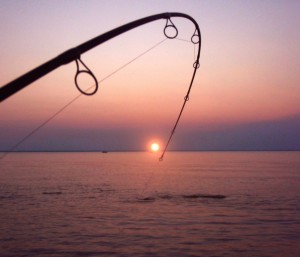 Only those become weary of angling
Only those become weary of angling
that bring nothing to it but the idea of
catching fish. – Raphael Sabatini
When I was in the eighth grade I read every book in the Mooresburg, Tennessee Elementary School library. Granted, it wasn’t a very big collection, but it still stands as a favorite personal accomplishment because I set the goal for myself and met the challenge. One of my favorite novels was the swashbuckling pirate story, The Sea Hawk by Raphael Sabitini. I imagine Sabitini must have been a good fisherman because he understood one of the fundamental principles of the sport: Anyone can catch a fish, but a true angler looks for a challenge. This time of year, catching rockfish is not really much of a challenge on the Chesapeake Bay. Although the stripers are rarely over 30 inches long, there are plenty of fish that are ready and willing to take almost any bait as long as the current is running. It’s the time when most of us look for birds and chase blitzing fish over hard, live bottoms. Some days are more challenging than others, but chances are there are working birds to be found for those who are willing to cover enough water. The fun of chasing breakers dulls after a while. Unless there are kids on the boat, or people who don’t fish much, the battle is won once you find the frenzied fish. Sometimes I’d just as soon sit and watch them because the result of casting a lure is predestined. To complicate things, we’re experiencing record high temperatures this June. Striped bass simply cannot survive when exposed to air temperatures over 90 degrees. In the heat of the Chesapeake summer, catch and release fishing is a very bad idea. Read More!
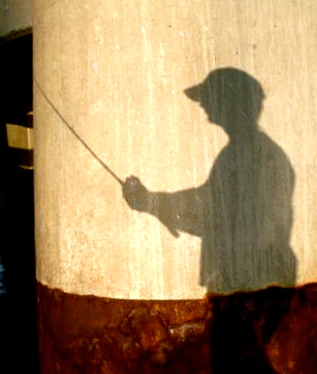 Summertime,
Summertime,
And the livin’ is easy
Fish are jumpin’
And the cotton is high
If I could add a line to George Gershwin’s song, it would be “and the piling bite is on.” This week marked the start of the summer pattern around the William Preston Lane Jr. Memorial Bridge. The migratory fish are long gone, the bluefish are moving in, and the resident rock have set up shop around the pilings. This is the time of year when it’s well-worthwhile to make a sunset run out of Matapeake to drop a jig around the rockpiles or toss a top-water plug over the Pipe. Go, even if there’s only a few minutes to fish. It’s the closest to a sure thing the Chesapeake has to offer. Better yet, the big white perch are out of the rivers and hanging out in the shallow water around the bridge. My wife and I ate fresh fish three times this past week. Back in the South, we’d call that steppin’ in high cotton. Here, it’s just a summer week on the Bay. Read More!
 I like to think I have a pretty good arsenal of fishing spots around Kent Island, but If you’d asked me a few weeks ago to point to Site 104 on a Chesapeake chart, I couldn’t have. In fact, until recently I’d never heard of the place or the environmental controversy that once swirled around it. I’ve just been going about my merry way, fishing when I can and fortunately finding success at one of my favorite locations in the Upper Bay. I now know that fishing spot has an interesting history, and I realize I have some people to thank for the exceptional spring fishing of 2010. If not for their work a decade ago, the place would be completely silted over.
I like to think I have a pretty good arsenal of fishing spots around Kent Island, but If you’d asked me a few weeks ago to point to Site 104 on a Chesapeake chart, I couldn’t have. In fact, until recently I’d never heard of the place or the environmental controversy that once swirled around it. I’ve just been going about my merry way, fishing when I can and fortunately finding success at one of my favorite locations in the Upper Bay. I now know that fishing spot has an interesting history, and I realize I have some people to thank for the exceptional spring fishing of 2010. If not for their work a decade ago, the place would be completely silted over.
I started fishing Site 104 when I first moved to this area in 2006. Underwater structure on live-bottoms along steep ledges is hard to find in the Chesapeake. Fishing out of my home base which was then on the Magothy River, I recognized early on that this was an easily accessible area likely to hold fish. The following spring I got a phone call from my new friend Steve Fogle of Backyard Custom Rods. He gave me a report of big fish at a specific location close to this place I was fishing. His hotspot turned out to be a narrow strip of underwater humps along the ancient Susquehanna river channel. Some of the humps were littered with blocks and boulders. Like Steve, I found the area extremely productive and began fishing it regularly in 2007. Read More!
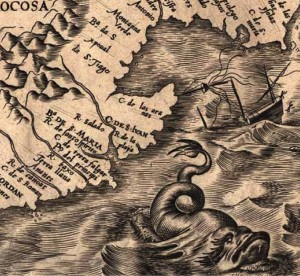 Certain ancient and medieval maps identify the edges of the known world with a Latin phrase that has piqued the curiosity of explorers for centuries: “Hic sunt gigantes.” While you won’t see the words on any Chesapeake charts, they could just as easily be penciled-in: “Here there be giants.” From mid-May to mid-June, gigantic Black Drum leave their spawning grounds near Cape Charles, VA to forage up the Bay. Maryland fishermen look for “boomers” around rocky bottoms in the Mid-bay, especially in the area just north and west of Sharps Island Light known as Stone Rock. The best way to catch them is to bait a circle-hook with soft crabs or clams and motor around looking for big marks on the sonar. Once they appear on the screen, drop the bait quickly. Drumfish aren’t known to be hard fighters but they are a challenge to land because of their sheer weight and massive girth. I’ve heard stories of fishermen struggling for hours before finally breaking them off. There are rumors of anglers who occasionally score one of the big-finned behemoths on a jig. I wasn’t so sure until yesterday when I saw one landed on light tackle. Read More!
Certain ancient and medieval maps identify the edges of the known world with a Latin phrase that has piqued the curiosity of explorers for centuries: “Hic sunt gigantes.” While you won’t see the words on any Chesapeake charts, they could just as easily be penciled-in: “Here there be giants.” From mid-May to mid-June, gigantic Black Drum leave their spawning grounds near Cape Charles, VA to forage up the Bay. Maryland fishermen look for “boomers” around rocky bottoms in the Mid-bay, especially in the area just north and west of Sharps Island Light known as Stone Rock. The best way to catch them is to bait a circle-hook with soft crabs or clams and motor around looking for big marks on the sonar. Once they appear on the screen, drop the bait quickly. Drumfish aren’t known to be hard fighters but they are a challenge to land because of their sheer weight and massive girth. I’ve heard stories of fishermen struggling for hours before finally breaking them off. There are rumors of anglers who occasionally score one of the big-finned behemoths on a jig. I wasn’t so sure until yesterday when I saw one landed on light tackle. Read More!
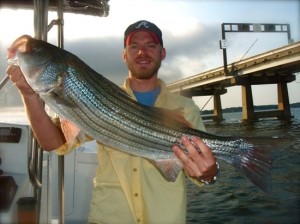 I have stories to tell, but not enough time to write. I’ll stick with the facts in this quick report and file more details when the good fishing slows down.
I have stories to tell, but not enough time to write. I’ll stick with the facts in this quick report and file more details when the good fishing slows down.
Fact 1: It’s been a May to remember for casting around Kent Island – the best out of the last four.
Fact 2: Jigging over hard, live bottoms in depths of 16-25 feet have been producing consistent 30″ + fish on the Bay side of the Island.
Fact 3: Jigging beneath menhaden schools in narrow deep channels is turning up mid-30s stripers in Eastern Bay.
Fact 4: Tossing top-water plugs around rocks and over shallow cover where there is good current is hot hot hot! Read More!
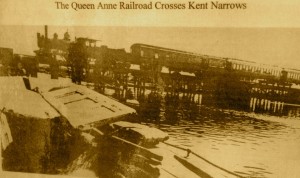 If you look in either direction off the Kent Narrows bridge you’ll see many dock bars, marinas, and restaurants, but you won’t see the Queen Anne’s Railroad Trestle. You won’t see it if you cruise through the Narrows by boat either. Most people will never know it’s there or what a good place to fish it is. I found the trestle a couple of years ago, but I didn’t know what it was. While watching my sonar screen one day I noticed a series of submerged wooden pilings. The pilings are about twelve feet below the surface and come up about six feet over an underwater ditch. When I first saw them I thought I was looking at a wreck, but it didn’t make sense that so many posts would be standing upright. My next guess was that it might be an abandoned fishing pier or maybe part of an old dock. Even though I always wondered about it, I knew it was a good fishing spot. Saturday, at the Kent Island Day festival in Historic Stevensville, I solved the mystery.
If you look in either direction off the Kent Narrows bridge you’ll see many dock bars, marinas, and restaurants, but you won’t see the Queen Anne’s Railroad Trestle. You won’t see it if you cruise through the Narrows by boat either. Most people will never know it’s there or what a good place to fish it is. I found the trestle a couple of years ago, but I didn’t know what it was. While watching my sonar screen one day I noticed a series of submerged wooden pilings. The pilings are about twelve feet below the surface and come up about six feet over an underwater ditch. When I first saw them I thought I was looking at a wreck, but it didn’t make sense that so many posts would be standing upright. My next guess was that it might be an abandoned fishing pier or maybe part of an old dock. Even though I always wondered about it, I knew it was a good fishing spot. Saturday, at the Kent Island Day festival in Historic Stevensville, I solved the mystery.


